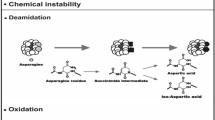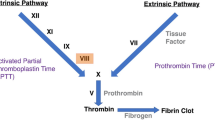Abstract
Human paraoxonase 1 (h-PON1) is a ~40 kDa multi-tasking enzyme that plays a major role in determining individual susceptibility towards various disease conditions. It is a strong candidate for the development of therapeutic intervention for various diseases and other conditions in humans. However, purified h-PON1 is unstable and there is a need to find condition(s) that can increase the shelf life of the enzyme. In this report, we present the results of our investigation on the effect of excipients on the stability of bacterially produced human PON1 when stored under different storage conditions. Our results show that (a) glycine and serine are most effective in stabilizing the enzyme when stored in aqueous buffer at 25 °C for 30 days, and (b) trehalose, maltose, and BSA exerted maximum stabilization effect when the enzyme was stored in freeze-dried form at 25 °C for 60 days. Results of this study can be used to increase the shelf life of purified h-PON1 enzyme.


Similar content being viewed by others
Notes
P. Bajaj, G. Aggarwal, R.K. Tripathy, and A.H. Pande, Interplay between amino acid residues at positions 192 and 115 in modulating hydrolytic activities of human paraoxonase 1. (submitted for publication).
Abbreviations
- h-PON1:
-
Human paraoxonase 1
- bph-PON1:
-
Bacterially produced human paraoxonase 1
- CMC:
-
Carboxy methyl cellulose
- PAA:
-
Polyacrylic acid
References
La Du BN, Aviram M, Billecke S, Navab M, Primo-Parmo S, Sorenson RC, Standiford TJ (1998) On the physiological role(s) of the paraoxonases. Chem Biol Interact, 119–120, 379–388
Ahmed, Z., Ravandi, A., Maguire, G. F., Emili, A., Draganov, D., La Du, B. N., Kuksis, A., & Connelly, P. W. (2002). Multiple substrates for paraoxonase-1 during oxidation of phosphatidylcholine by peroxynitrite. Biochem Biophys Res Commun, 290, 391–396.
Mackness, B., & Mackness, M. (2010). Anti-inflammatory properties of paraoxonase-1 in atherosclerosis. Adv Exp Med Biol, 660, 143–151.
Shih, D. M., Gu, L., Xia, Y. R., Navab, M., Li, W. F., Hama, S., Castellani, L. W., Furlong, C. E., Costa, L. G., & Fogelman, A. M. (1998). Mice lacking serum paraoxonase are susceptible to organophosphate toxicity and atherosclerosis. Nature, 394, 284–287.
Koren-Gluzer, M., Aviram, M., Meilin, E., & Hayek, T. (2011). The antioxidant HDL-associated paraoxonase-1 (PON1) attenuates diabetes development and stimulates beta-cell insulin release. Atherosclerosis, 219, 510–518.
Li, W. F., Furlong, C. E., & Costa, L. G. (1995). Paraoxonase protects against chlorpyrifos toxicity in mice. Toxicol Lett, 76, 219–226.
Camps, J., Pujol, I., Ballester, F., Joven, J., & Simo, J. M. (2011). Paraoxonases as potential antibiofilm agents: their relationship with quorum-sensing signals in gram-negative bacteria. Antimicrob Agents Chemother, 55, 1325–1331.
Chambers, J. E. (2008). PON1 multitasks to protect health. Proc Natl Acad Sci, 105, 12639–12640.
Tavori, H., Vaya, J., & Aviram, M. (2010). Paraoxonase 1 attenuates human plaque atherogenicity: relevance to the enzyme lactonase activity. Adv Exp Med Biol, 660, 99–111.
Lenz, D. E., Yeung, D., Smith, J. R., Sweeney, R. E., Lumley, L. A., & Cerasoli, D. M. (2007). Stoichiometric and catalytic scavengers as protection against nerve agent toxicity: a mini review. Toxicology, 233, 31–39.
Rochu, D., Chabriere, E., & Masson, P. (2007). Human paraoxonase: a promising approach for pre-treatment and therapy of organophosphorus poisoning. Toxicology, 233, 47–59.
Ritcher, R. J., Jarvik, G. P., & Furlong, C. E. (2010). Paraoxonase 1 status as a risk factor for disease or exposure. Adv Exp Med Biol, 660, 29–35.
Gugliucci, A. (2010). Beyond the antioxidant properties: pomegranate juice polyphenols increase hepatocyte paraoxonase 1 secretion. Atherosclerosis, 208, 28–29.
Gan, K. N., Smolen, A., Eckerson, H. W., & La Du, B. N. (1991). Purification of human serum paraoxonase/arylesterase: evidence for one esterase catalyzing both activities. Drug Metab Dispos, 19, 100–106.
Golmanesh, L., Mehrani, H., & Tabei, M. (2008). Simple procedures for purification and stabilization of human paraoxonase 1. J Biochem Biophys Methods, 70, 1037–1042.
Rochu, D., Renault, F., Cléry-Barraud, C., Chabrière, E., & Masson, P. (2007). Stability of highly purified human paraoxonase (PON1): association with human phosphate binding protein (HPBP) is essential for preserving its active conformation(s). Biochim Biophys Acta, 1774, 874–883.
Nguyen, S. D., & Sok, D. E. (2003). Beneficial effect of oleoylated lipids on paraoxonase 1: protection against oxidative inactivation and stabilization. Biochem J, 375, 275–285.
Otto, T. C., Kasten, S. A., Kovaleva, E., Liu, Z., Buchman, G., Tolosa, M., Davis, D., Smith, J. R., Balcerzak, R., & Lenz, D. E. (2010). Purification and characterization of functional human paraoxonase-1 expressed in Trichoplusia ni larvae. Chem Biol Interact, 187, 388–392.
Draganov, D. I., Teiber, J. F., Speelman, A., Osawa, Y., Sunahara, R., & La Du, B. N. (2005). Human paraoxonases (PON1, PON2, and PON3) are lactonases with overlapping and distinct substrate specificities. J Lipid Res, 46, 1239–1247.
Manning, M. C., Chou, D. K., Murphy, B. M., Payne, R. W., & Katayama, D. S. (2010). Stability of protein pharmaceuticals: an update. Pharm Res, 27, 544–575.
Jeong, S. H. (2010). Analytical methods and formulation factors to enhance protein stability in solution. Arch Pharm Res, 35, 1871–1886.
Ohtake, S., Kita, Y., & Arakawa, T. (2011). Interactions of formulation excipients with proteins in solution and in the dried state. Adv Drug Deliv Rev, 63, 1053–1073.
Arakawa, T., Tsumoto, K., Kita, Y., Chang, B., & Ejima, D. (2007). Biotechnology applications of amino acids in protein purification and formulations. Amino Acids, 33, 587–605.
Timasheff, S. N. (2002). Protein-solvent preferential interactions, protein hydration, and the modulation of biochemical reactions by solvent components. Proc Natl Acad Sci, 99, 9721–9726.
Timasheff, S. N. (1995). Solvent stabilization of protein structure. Methods Mol Biol, 40, 253–269.
Arakawa, T., Pretrelskia, S. J., Kenneya, W. C., & Carpenter, J. F. (2001). Factors affecting short-term and long-term stabilities of proteins. Adv Drug Deliv Rev, 46, 307–326.
Simpson, R. J. (2010). Stabilization of proteins for storage. Cold Spring Harbor Protocol. doi:10.1101/pdb.top79.
Bhambhani, A., Kissman, J. M., Joshi, S. B., Volkin, D. B., Kashi, R. S., & Middaugh, C. R. (2012). Formulation design and high-throughput excipient selection based on structural integrity and conformational stability of dilute and highly concentrated IGg1 monoclonal antibody solutions. J Pharm Sci, 101, 1120–1135.
Mueller, M., Loh, M. Q. T., Tee, D. H. Y., Yang, Y., & Jungbauer, A. (2013). Liquid formulations for long-term storage of monoclonal IgGs. Appl Biochem Biotechnol, 169, 1431–1448.
Hasset, K. J., Cousins, M. C., Rabia, L. A., Chadwick, C. M., Ohara, J. M., Nandi, P., Brey, R. N., Mantis, N. J., Carpenter, J. F., & Randolf, T. W. (2013). Stabilization of a recombinant ricin toxin A subunit vaccine through lyophilisation. Eur J Pharm Biopharm, 85, 279–286.
Sambrook, J., Fritsch, E. F., & Maniatis, T. (2001). Molecular cloning: a laboratory manual (2nd ed.). Cold Spring Harbor: Cold Spring Harbor Laboratory Press.
Middelberg, A. P. (2001). Preparative protein refolding. Trends Biotechnol, 20, 437–443.
Kar, S., Patel, M. A., Tripathy, R. K., Bajaj, P., Suvarnakar, U. V., & Pande, A. H. (2012). Oxidized phospholipid content destabilizes the structure of reconstituted high density lipoprotein particles and changes their function. Biochim Biophys Acta, 1821, 1200–1210.
Chi, E. Y., Krishnan, S., Randolph, T. W., & Carpenter, J. F. (2003). Physical stability of proteins in aqueous solution: mechanism and driving forces in nonnative protein aggregation. Pharm Res, 20, 1325–1336.
Carpenter, J. F., Pikal, M. J., Byeong, S., & Randolph, T. W. (1997). Rational design of stable lyophilized protein formulations: some practical advice. Pharm Res, 14, 969–975.
Arakawa, T., Ejima, D., Tsumoto, K., Obeyama, N., Tanaka, Y., Kita, Y., & Timshaff, S. N. (2007). Suppression of protein interactions by arginine: a proposed mechanism of the arginine effects. Biophys Chem, 127, 1–8.
Arakawa, T., Carpenter, J. F., Kita, Y. A., & Crowe, J. H. (1990). The basis for toxicity of certain cryoprotectants: a hypothesis. Cryobiology, 27, 401–415.
Franks, F., & Hatley, R. H. M. (1991). Stability of proteins at subzero temperatures: thermodynamics and some ecological consequences. Pure Appl Chem, 63, 1367–1380.
Hatley, R. H. M., & Franks, F. (1986). Denaturation of lactate dehydrogenase at subzero temperatures. Cryo-Letters, 7, 226–233.
Chang, B. S., Kendrick, B. S., & Carpenter, J. E. (1996). Surface-induced denaturation of proteins during freezing and its inhibition by surfactants. J Pharm Sci, 85, 1325–1330.
Fields, G. B., Alonso, D. O. V., Stigter, D., & Dill, K. A. (1992). Theory for the aggregation of proteins and copolymers. J Phys Chem, 96, 3974–3981.
Privalov, P. L. (1990). Cold denaturation of proteins. Crit Rev Biochem Mol Biol, 25, 281–305.
Bock, P. E., & Frieden, C. (1978). Another look at the cold lability of enzymes. Trends Biochem Sci, 3, 100–103.
Ondrias, M. R., Rousseau, D. L., & Simon, S. R. (1981). Structural changes at the heme induced by freezing. Science, 213, 559–657.
Carpenter, J. F., Crowe, L. M., & Crowe, J. H. (1987). Stabilization of phosphofructokinase with sugars during freeze-drying: characterization of enhanced protection in presence of divalent cations. Biochim Biophys Acta, 923, 109–115.
Carpenter, J. F., Martin, B., Crowe, L. M., & Crowe, J. H. (1987). Stabilization of phosphofructokinase during air-drying with sugars and sugar/transition metal mixtures. Cryobiology, 24, 455–464.
Crowe, J. H., Carpenter, J. F., Crowe, L. M., & Anchordoguy, T. J. (1990). Are freezing and dehydration similar stress vectore? A comparison of modes of interaction stabilizing solutes with biomolecules. Cryobiology, 27, 219–231.
Schachman, H. K., & Lauffer, M. A. (1949). The hydration, size and shape of tobacco mosaic virus. J Am Chem Soc, 71, 536–541.
Carpenter, J. F., Prestrelski, S. J., Anchrodoguy, T. J., & Arakawa, T. (1994). Interactions of stabilizers with proteins during freezing and drying, in formulation and delivery of proteins and peptides (pp. 134–147). Washington DC: ACS Symposium Series; American Chemical Society.
Crowe, L. M., Reid, D. S., & Crowe, J. H. (1996). Is trehalose special for preserving dry biomaterials? Biophys J, 71, 2087–2093.
Jain, N. K., & Roy, I. (2009). Effect of trehalose on protein structure. Protein Sci, 18, 24–36.
Chang, L., Shepherd, D., Sun, J., Ouellette, D., Grant, K. L., Tang, X., & Pikal, M. J. (2005). Mechanism of protein stabilization by sugars during freeze-drying and storage: native structure preservation, specific interaction, and/or immobilization in a glassy matrix? J Pharm Sci, 94, 1427–1444.
Acknowledgments
This work was supported by the research grants to AHP from NIPER, SAS Nagar. The authors thank Prof. K.P.R. Kartha, Department of Chemistry, NIPER-SAS Nagar, for his valuable assistance in writing the manuscript. Priyanka Bajaj (CSIR-SPM-SRF) is thankful to CSIR, New Delhi, for financial support in the form of CSIR Fellowship.
Author information
Authors and Affiliations
Corresponding author
Rights and permissions
About this article
Cite this article
Bajaj, P., Pande, A.H. Stabilization Studies on Bacterially Produced Human Paraoxonase 1 for Improving Its Shelf Life. Appl Biochem Biotechnol 172, 3798–3809 (2014). https://doi.org/10.1007/s12010-014-0806-5
Received:
Accepted:
Published:
Issue Date:
DOI: https://doi.org/10.1007/s12010-014-0806-5




